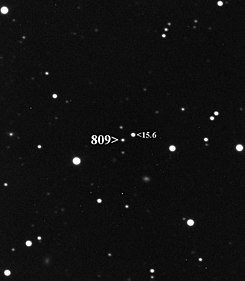809 Lundia
809 Lundia is a small, binary, V-type asteroid[3] orbiting in the Flora family in the Main Belt. It is named after Lund Observatory, Sweden.
 Asteroid 809 Lundia (apparent magnitude 16.6) near a mag 15.6 star | |
| Discovery | |
|---|---|
| Discovered by | Max Wolf |
| Discovery date | 11 August 1915 |
| Designations | |
| MPC designation | (809) Lundia |
| Pronunciation | /ˈlʌndiə/ |
Named after | Lund Observatory |
| 1915 XP; 1936 VC | |
| Main belt | |
| Orbital characteristics[1] | |
| Epoch 31 July 2016 (JD 2457600.5) | |
| Uncertainty parameter 0 | |
| Observation arc | 100.48 yr (36700 d) |
| Aphelion | 2.72316 AU (407.379 Gm) |
| Perihelion | 1.84193 AU (275.549 Gm) |
| 2.28254 AU (341.463 Gm) | |
| Eccentricity | 0.19304 |
| 3.45 yr (1259.6 d) | |
| 76.7867° | |
| 0° 17m 8.912s / day | |
| Inclination | 7.14911° |
| 154.580° | |
| 196.162° | |
| Physical characteristics | |
| Dimensions | 10.26 ± 0.07 km[2] |
| Mass | (9.27 ± 3.09) × 1014 kg[2] |
Mean density | 1.64 ± 0.10 g/cm3[2] |
| 15.4142 h (0.64226 d) | |
| V | |
| 12.2 | |
The V-type spectrum says that it is not genetically related to the Flora family, but rather is probably a piece (actually two pieces) blown off the surface of nearby 4 Vesta by a big impact in the past. Its orbit is too far from Vesta for it to actually be a member of the Vesta family It is not clear how it came at an orbit so far from Vesta, but other examples of V-type asteroids fairly far from their parent body are known. A mechanism of interplay between the Yarkovsky effect and nonlinear secular resonances (mainly involving Jupiter and Saturn) has been suggested.[4]
Binary
A moon, designated S/2005 (809) 1, was seen based on lightcurve sightings in 2005. In fact, the size of the two bodies appear to be close in size, because during mutual occultations the brightness drops by a similar amount independently of which body is hidden.[5] Assuming an albedo similar to 4 Vesta (around 0.4), suggests that the bodies are about 7 km across. It takes 15.4 hours to orbit each other,[5] which says that the binary is very close — the separation being of the order of 10–20 km, if normal asteroid albedo and density values are assumed.
References
- ↑ "809 Lundia (1915 XP)". JPL Small-Body Database. NASA/Jet Propulsion Laboratory. Retrieved 4 May 2016.
- ↑ 2.0 2.1 2.2 Carry, B. (December 2012), "Density of asteroids", Planetary and Space Science, 73: 98–118, arXiv:1203.4336, Bibcode:2012P&SS...73...98C, doi:10.1016/j.pss.2012.03.009, S2CID 119226456. See Table 1.
- ↑ M. Florczak, D. Lazarro, & R. Duffard (2002). "Discovering New V-Type Asteroids in the Vicinity of 4 Vesta". Icarus. 159: 178–182. doi:10.1006/icar.2002.6913.
{{cite journal}}: CS1 maint: multiple names: authors list (link) - ↑ V. Carruba; et al. (2005). "On the V-type asteroids outside the Vesta family". Astronomy & Astrophysics. 441 (2): 819–829. doi:10.1051/0004-6361:20053355. S2CID 18658829.
- ↑ 5.0 5.1 Poznań observatory [1] Archived 2001-07-02 at the Wayback Machine (Lightcurve showing signature of the binary)